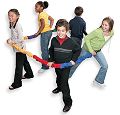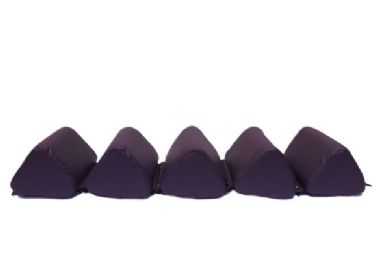
Pediatric exercise therapy is critical for healthy growth and development in children. Exercise also has therapeutic benefits for those who suffer from a chronic disease or disability.
Rehabmart is proud to offer an extensive line of pediatric exercise therapy products from top quality venders that include Somatron, TFH, KidsFit, Southpaw Enterprises, Original Baby Company and Asa Products Inc.

Increasing physical activity in children joins other preventative and proactive health measures designed to promote the highest possible growth and development. These measures include eating healthy foods, and obtaining and maintaining a healthy weight. This helps reduce the risk of chronic diseases that can develop as an adult. Strength training, also called resistance training, is a common part of physical fitness programs and sports for youth. It may include using free weights, weight machines, an athlete’s own body weight, or elastic tubing. Children can benefit from strengthening exercises, but they need to be fun. The exercises work the core muscles and help to achieve stability, better posture, and endurance, without the child getting bored. Kids who are physically fit sleep better and are better able to handle physical and emotional challenges.
What Diseases can Exercise Therapy Help Prevent?
Osteoporosis causes serious and disabling bone fractures in older adults. It can result from not doing enough bone building during childhood and adolescent years. Physical activity helps build greater bone density in childhood and helps maintain peak bone density in adulthood. To develop strong bones, kids need to participate in weight-bearing physical activities. These include walking, playing soccer, jumping rope and playing basketball.
Physical activity is crucial in fighting obesity. The percentage of overweight kids and teens has more than doubled in the past 30 years. Combined with a moderate cutback in calories and family intervention, exercise can produce a significant reduction in the occurrence of childhood obesity. An important activity related to intervention is reducing sedentary behavior, such as playing computer games and watching TV, videos and DVDs. Obesity during childhood is a risk factor for type 2 diabetes mellitus in adults.
Abnormally high blood pressure, also called hypertension, causes strokes, coronary artery disease, renal failure, congestive heart failure and peripheral vascular disease in adults. Most of these conditions are usually hereditary and often develop during childhood. Regular physical activity can help lower blood pressure substantially in children, adolescents and adults.
Mental health can be improved with regular physical activity. Participating in exercises can enhance a child’s self-esteem and reduce symptoms of anxiety and depression in children with emotional disorders or developmental disabilities.
Children with cerebral palsy can benefit from exercises to develop strength and skill. A child can begin to build core strength through continuous practice of movements against gravity, even if their movement patterns are limited. Strengthening exercises can be beneficial for long-term functional gains, improved movement patterns and optimal posture. Exercise programs lessen the deterioration of functional capacity as the child ages, and improve range of motion, strength and endurance.
Asthma can cause a chronic and disruptive illness throughout a child’s life. It can lead to long-term health impairments, such as chronic lung disease. Therefore, exercise is necessary for healthy development and growth. Sedentary children with this disease are at increased risk for cardiovascular problems later in life, and inactivity can aggravate the underlying condition.
How does Exercise Therapy Benefit the Brain?
Physical exercise helps the brain before it helps the body. Since the brain does not store or produce its own fuel, it relies on the body to get its needed fuel, which is glucose and oxygen. The brain functions more efficiently when the body is healthier and more physically fit. This is because physical exercise changes the brain at a molecular level. It does this by growing new brain cells (neurogenesis), producing the fertilizer for the brain (brain-derived neurotropic factor), strengthening secondary branching that increases memory retrieval, and improving mood by balancing dopamine, cortisol, and serotonin (the neurotransmitters’ endorphins). The brain is very complex. More parts of the brain are used when a person is moving or physically active.
Exercise creates the perfect environment for the ability of the brain to change. It puts the body and brain in balance naturally by regulating the chemicals that control responses to stress and mood. Physical exercise improves the brain’s function by increasing its capacity for learning, enhancing the memory center of the brain, and protecting the brain’s functions for heightened health. Social skills and behavior are improved with physical exercise, along with academic performance. It enhances cognition by improving perception, mental performance, memory, decision making, learning, attention and multi-tasking. Exercise improves short-term and long-term memory, and delays signs and symptoms of dementia. Stress is reduced by exercise, along with decreasing depression and improving the ability to adapt to a changing environment.
What are the Elements of Fitness?
There are three elements of fitness in action when children run away from who’s “it” (endurance), cross the monkey bars (strength), and bend down to tie their shoes (flexibility). Children should be encouraged to do a variety of activities so they can work on all three of these elements.
Endurance is developed when kids regularly take part in aerobic activity--when the heart beats faster and they breathe harder. Aerobic activity strengthens the heart and improves the body’s ability to deliver oxygen when done regularly and for extended periods of time. Some examples of aerobic activities include basketball, bicycling, ice-skating, inline skating, soccer, swimming, tennis, walking, jogging and running.
Strength does not just mean lifting weights. If weight lifting is done, is should be under the supervision of an experienced adult. Strength can come from being active and using the muscles.
Flexibility is improved with stretching exercises. This allows the muscles and joints to bend and move easily through their full range of motion. Kids stretch every day when they try to get a toy that is just out of reach, practice the splits, or do a cartwheel.
How much Exercise is Enough?
Pediatric exercise recommendations are becoming more important. Infants should be encouraged to do physical activity to help develop their motor skills. Toddlers need 90 minutes of daily activity, which includes 30 minutes of planned physical activity and 60 minutes of unstructured free play time. Preschoolers should have 2 hours of daily activities that include 60 minutes of planned exercise and 60 minutes of unstructured free play time. School age kids need at least 60 minutes of daily activity, which can be broken up into 15 minute increments.
Young children and infants should not be inactive for long periods of time of more than one hour in duration, unless they are sleeping. School age kids should not be inactive for periods longer than two hours at a time. Active and inactive children need to be educated on the benefits of exercise, its safety, and what is recommended according to age.
Choosing the right activities for a child’s age will keep them from getting bored or frustrated with it. By providing equipment to make activity easy, kids will have more opportunities to be active. No matter what the activity, the focus needs to stay on keeping it fun because kids will not do something they do not enjoy. As a child’s ability in an activity improves, praise gives them a sense of accomplishment. These good feelings increase their desire to continue with that activity or to try others.
Kids have fitness personalities that need to be considered when trying different activities. Personality traits, genetics, and athletic ability influence their attitude towards participating, especially as they get older. Understanding these concepts will enable the child to find the right physical activities that suit their unique requirements best. The non-athlete may lack athletic ability, and/or interest in physical activity. They will need more encouragement to get and stay active. The casual athlete is interested but is not a star player. They are at risk of getting discouraged in competitive play. The athlete has athletic ability and is committed to a sport or activity at an intense level. Starting physical activities at an early age will enable a child to think of them as a normal and fun part of their daily routine.
Hulet Smith, OT
Rehabmart Co-Founder & CEO
lb